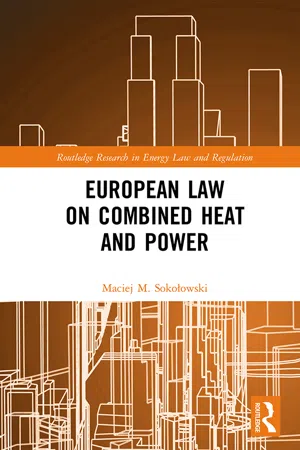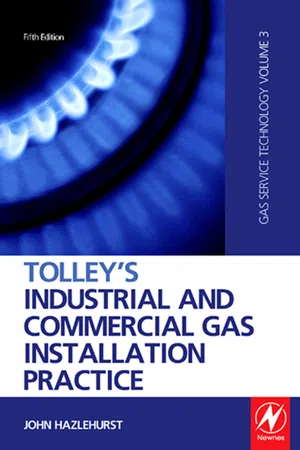Cogeneration
Cogeneration, also known as combined heat and power (CHP), is a process where a single fuel source is used to generate both electricity and useful heat. This efficient method reduces energy waste by utilizing the heat that is typically lost in conventional power generation. Cogeneration systems are commonly used in industrial and commercial settings to improve energy efficiency and reduce environmental impact.
7 Key excerpts on "Cogeneration"
- eBook - ePub
- Maciej M. Soko?owski(Author)
- 2020(Publication Date)
- Routledge(Publisher)
...1 Introduction More heat, more power, less energy “Promoting combined heat and power production (CHP or co-generation) is considered an important part of the Community energy policy for improving energy efficiency. CHP also plays a crucial role in helping meet the commitments of reducing greenhouse gas emissions”, as reported by the Eurostat (2001, p. 2) almost 20 years ago. “CHP is good engineering, good economics and good business” informs the UK branch of transnational water-waste-energy company Veolia (n.d.). “Cogeneration helps consumers and businesses to take control over their energy future by making them the active beneficiaries of an integrated energy system and rewarding them for the benefits they bring to the system” declares COGEN Europe (n.d). Cogeneration offers efficiency, environmental, economic, and reliability benefits – enumerates the US Environmental Protection Agency (n.d. a). Cogeneration represents “a series of proven, reliable and cost-effective technologies that are already making an important contribution to meeting global heat and electricity demand” – assures the International Energy Agency (2009, p. 11). The aforementioned quotations briefly highlight some basic features of combined heat and power, sketching the main fields related to Cogeneration which are presented, juxtaposed, and examined in this book. Among them, a special position is granted to energy efficiency – on which the reciprocal benefits of CHP are built (e.g. producing more heat and more electricity using less energy, as highligted in the title of this part of the book). Those issues – put into a regulatory framework created by the European policies and law on CHP – are analysed in the following chapters of this study (the outcome of my research work)...
- Asif Syed(Author)
- 2012(Publication Date)
- Wiley(Publisher)
...CHAPTER 11 Cogeneration Cogeneration IS ALSO REFERRED TO AS COMBINED HEAT AND power generation (CHP). Cogeneration is the process of simultaneously generating two forms of energy: electrical power and heat. In standard power generation, electrical energy is used, but heat is wasted by exhausting it through the stack. Cogeneration recovers the heat energy that would have been lost and puts it to use. The heat energy can be used in several ways, including space heating in winter, absorption cooling or air conditioning in summer, and domestic hot water use year-round. Another unique feature of Cogeneration is that it is localized, or located at the point of use of energy. Cogeneration produces electrical power and heat at the consumer’s site, avoiding the purchase of electricity from a utility company. Electrical generation with fossil fuel is normally done via gas boilers, which burn to produce heat; the heat produces steam to drive the turbines, which in turn power the generators, producing electricity. Another form of electrical power generation with fossil fuels uses direct-fired equipment such as gas turbines and internal combustion engines. Fossil fuel is burned directly in the engine or turbine, which powers the generators, producing electricity. In both turbines and internal combustion engines, heat energy is converted into electrical energy. The process of conversion of heat energy to electrical energy is only 30 to 40 percent efficient; 60 to 70 percent of the heat is released to the atmosphere via a flue stack or cooling tower. Of all the energy produced in the United States, 63.9 percent is lost in the conversion process; 1 or, two-thirds of the fuel used to generate power is lost as heat. Figure 11-1 Conventional power plant efficiency. Asif Syed The location of the plant where power is generated is important, if the waste heat has to be captured and used...
- John Hazlehurst(Author)
- 2010(Publication Date)
- Routledge(Publisher)
...Chapter | ten Combined Heat and Power Chapter 10 is written by R. Proffitt INTRODUCTION Combined heat and power is often abbreviated as CHP. It is not a new concept and has been known for many years. In the late 1960s, the term ‘total energy’ was used to describe the situation where only one energy form was supplied to provide all the energy needs of a building. This is achieved by supplying gas to generate electricity from gas engines or gas turbines and use the waste heat to heat the building or to use for process purposes. This technique allows about 80–85% of the energy supplied to be used with a loss of only 15–20% compared to the electricity generation process at the power station being 34% efficient in producing electricity. This is shown diagrammatically in Figs 10.1 and 10.2. Figure 10.1 Electric power supply efficiency. Figure 10.2 Sankey diagram for electricity production with waste heat recovery. Figure 10.1 is based upon information supplied by the Electricity Council and shows that the overall efficiency of electricity supply and usage from the national grid is only about 26%. The ratio in price between electricity and gas is 4:1 and this reflects the loss of over 70% of the energy supplied to the power station. In CHP schemes much of the waste heat is recovered. In Fig. 10.2 the output of electricity is the same but in addition there are 59 units of useful heat. Figure 10.3 shows this principle applied to a practical installation at a leisure centre containing a swimming pool...
- eBook - ePub
- Paul Breeze(Author)
- 2014(Publication Date)
- Newnes(Publisher)
...Chapter 6 Combined Heat and Power Abstract All combustion power plants operate inefficiently, with much of the fuel energy going to waste as heat. This heat can be exploited in a variety of ways, raising the overall efficiency of the power plant. Heat is used for district heating in some US and European cities but this has not proved widely popular. Some industries can also make use of steam for their processes. Wood and paper processing factories will often have their own power plant that supplies both heat and electricity. Combined heat and power plants are most effective when both electricity and heat are supplied to the same customers. Many types of power generation plant can be used for combined heat and power but coal-fired boilers, gas turbines and piston engine-based systems are the most common. Fuel cells can also be exploited. Sizing a combined heat and power plant correctly is the key to economic viability. Keywords combined heat and power CHP Cogeneration district heating process heat steam generation gas turbine micro-turbine fuel cell The production of electricity from coal, oil, gas, and biomass is an inefficient process. While some modern combustion plants can achieve 60% energy conversion efficiency, most operate closer to 30%, and smaller or older units may reach only 20%. The United States, which has a typical developed-world mix of fossil fuel–based combustion plants, achieves an average power plant efficiency of 33%, a level that has barely shifted for the past 30 years. Other countries would probably struggle to reach even this level of efficiency. Put another way, between 40% and more than 80% of all the energy released during combustion in power plants is wasted. The wasted energy emerges as heat that is dumped in one way or another. Sometimes it ends up in cooling water that has passed through a power plant and then returned to a river or the sea, but most often it is dissipated into the atmosphere through some form of air–heat exchanger...
- eBook - ePub
- D. Paul Mehta, Albert Thumann(Authors)
- 2021(Publication Date)
- River Publishers(Publisher)
...For example, take a situation in which an engine drives a generator that produces electricity: with Cogeneration, heat would be recovered from the engine exhaust and/or coolant, and that heat would be used to produce, say, hot water. Making use of waste heat is what differentiates Cogeneration facilities from central station electric power generation. The overall fuel utilization efficiency of Cogeneration plants is typically 70-80% versus 35-40% for utility power plants. This means that in Cogeneration systems, rather than using energy in the fuel for a single function, as typically occurs, the available energy is cascaded through at least two useful cycles. To put it in simpler terms: Cogeneration is a very efficient method of making use of all the available energy expended during any process generating electricity (or shaft horsepower) and then utilizing the waste heat. A more subjective definition of Cogeneration calls upon current practical applications of power generation and process needs. Nowhere more than in the United States is an overall system efficiency of only 30% tolerated as “standard design.” In the name of limited initial capital expenditure, all of the waste heat from most processes is rejected to the atmosphere. In short, present design practices dictate that of the useful energy in one gallon of fuel, only 30% of that fuel is put to useful work. The remaining 70% is rejected randomly. If one gallon of fuel goes into a process, the designer may ask, “How much of that raw energy can I make use of within the constraints of the overall process?” In this way, Cogeneration may be taken as a way to use a maximum amount of available energy from any raw fuel process...
- eBook - ePub
- DENNIS A SNOW(Author)
- 2001(Publication Date)
- Butterworth-Heinemann(Publisher)
...22 Electricity generation I G Crow, BEng, PhD, CEng, FIMechE, FIMarE, MemASME, BM & T Consulting Ltd K Shippen, BSc, MBA, CEng, MIMechE, Chieftain Power Services Contents Introduction Generation of electrical power Diesels Gas turbines Thermal power plant Gas turbines in combined cycle Combined heat and power (CHP) Steam turbines for CHP Diesels and gas turbines in combined heat and power Factors influencing choice The available fuels The electrical load profile The heat load Power station auxiliary systems and services Site conditions Plant availability and maintenance Environmental aspects Generated voltages The selection For electrical power For combined heat and power Economic considerations Plant and installation Diesel power plants Gas turbine power plants Steam turbogenerators Generators 22.1 Introduction Electricity is one of the key energy sources for industry and commerce. It is normally provided by the electricity supply companies, being generated from large fossil-fuelled, gas or nuclear central power stations and distributed throughout the country via high-voltage transmission systems. It can be fair to say that the electricity supply companies play a very important part in meeting the demands of the consumer efficiently, reliably and at an economic cost. However, there will always be a role for the private generation of electrical power, either to meet the needs for security of supply or to provide the electricity more economically. For the latter this is particularly the case for the concept of combined heat and power (CHP), where the local use of a heat demand can make private generation of electricity more competitive when compared with purchase from the local grid. This chapter aims to convey the basic technical principles involved in electricity generation for industrial and commercial applications, with supporting technical data giving examples of the performance and efficiency of various schemes...
- eBook - ePub
- Paul Breeze(Author)
- 2016(Publication Date)
- Academic Press(Publisher)
...This could be achieved with a closed cycle turbine such as an organic Rankine cycle. Such turbines can exploit low grade heat to produce electricity and are used in some geothermal plants where the temperature of the geothermal reservoir is relatively low. However, it is unlikely to be economically viable to add this third cycle to a modern combined cycle plant. 7.1 Evolution of the Combined Cycle Concept The first gas turbine that was ever sold commercially for use in a power station to generate electricity operated in a sort of combined cycle mode. The 3.5 MW unit was installed at the Belle Isle Station in Oklahoma in 1949. Belle Isle was an established fossil fuel-fired steam power station and the heat in the exhaust gases of the gas turbine was used to heat the feed-water for the boiler of the steam plant, boosting steam plant output. In later applications of gas turbines, during the 1950s and 1960s, the exhaust gas from a gas turbine was used as the combustion air for a conventional fossil fuel-fired boiler. This added a few percentage points to overall efficiency. Other early combined cycle power plants were created by repowering fossil fuel plants, replacing the coal furnace with a gas turbine but using the steam generator and steam turbine of the original plant to exploit the heat in the gas turbine exhaust. The development in the 1950s of more advanced boiler tubes with spiral fins welded to the central tube gradually made it possible to build a more effective heat recovery steam generator (HRSG) for energy capture from a gas turbine exhaust. Many of the first plants to employ this new technology were Cogeneration plants that produced electricity and steam but a small number of these steam generators were used in utility power plants. This established the modern gas turbine power station. The basic combined cycle configuration consists of a gas turbine, a HRSG and a steam turbine...






